Everything To Know About Tomahawk Missiles: Speed, Cost, And Destructive Power
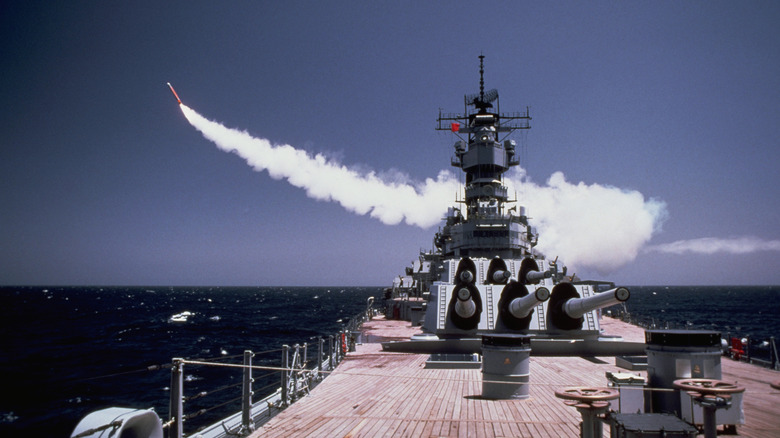
Tomahawk missiles have been world famous since the first Gulf War in 1991 when the United States used the missile against Saddam Hussein's forces in Iraq and Kuwait. Since then, the missile system has been used in nearly every conflict the United States has been involved in, including recent strikes against Houthi rebels in Yemen. Given the weapon's ubiquity, it's worth exploring what exactly a Tomahawk missile is. The United States Navy reports that over 2,300 Tomahawks have been deployed in combat, with that number increasing by the day.
According to the Missile Defense Project from the Center for Strategic and International Studies, the Tomahawk (full name Tomahawk Land Attack Missile) has been in service since 1983 and were first developed for the United States Navy starting in 1972. It was designed to be launched from ships or submarines and was, from the outset, made with nuclear payloads in mind. However, nuclear-armed Tomahawks have not been used in combat and are currently deactivated.

Slow and steady
The Tomahawk missile itself is a 20.3 foot long craft with a wingspan of eight and a half feet, and it weighs 3,330 pounds with all of its components. It's powered by both a rocket booster and turbofan jet engine made by Williams International. According to PBS, the rocket booster engine launches the Tomahawk in the air (hence all the smoke you may see in news broadcasts or photos you see of the missile) and then its jet engine takes the missile the rest of the way to its target.
Despite being powered by rockets and a jet engine, the Tomahawk missile itself isn't that fast, at least comparatively. It reportedly travels at a speed of around 550 miles per hour. An F-16 fighter jet tops out at 1,500 miles per hour and the much larger Minuteman III ballistic missile can reach speeds of up to 15,000 miles per hour. Supposedly, the Tomahawk's relatively low speed helps it avoid radar systems more efficiently. Additionally, it flies at an altitude of between 100 and 300 feet, much lower than conventional fighter aircraft.
Range and power
The actual payload of the Tomahawk can consist of a number of different munitions. But the primary warhead of the Tomahawk is a 1,000-pound high explosive charge. It can also carry cluster munitions consisting of small bomblets, similar to the ATACMS currently used in Ukraine . For explosive force, Tomahawks were more than enough to disable runways or sink ships.
The exact guidance system and navigational dynamics of the Tomahawk missile are classified. However, it is known that it can use GPS or inertial guidance systems to hit the target. Additionally, the U.S. Navy states that up to 15 targets can be pre-programmed for missile salvos. The Tomahawk is capable of "loitering," meaning that, provided the missile has enough fuel, it can fly around in circles to relay information or wait for the right target. It has a range of around 1,500 miles, meaning that the ship or submarine launching the missile is well out of harm's way. It is accurate to within 10 meters.
The Tomahawk's combat history
The Tomahawk is primarily made by Raytheon Missile Systems. According to budget data from the United States Marine Corps from 2022, each Tomahawk costs around $2 million. As of now, the United States and the United Kingdom are the only countries to deploy Tomahawk missiles, although Australia and Japan have put out bids to purchase Tomahawks.
The U.S. Navy states that 140 total craft are capable of launching Tomahawks. That number consists of Ohio-class submarines, Arleigh Burke-class destroyers, and more. The United States Army has also tested launching Tomahawks from ground-based platforms. The USS Missouri, a World War II-era battleship and the very last of its kind, was fitted to fire Tomahawks during the opening salvos of the First Gulf War. It fired a total of 28 cruise missiles, in addition to its 16-inch deck guns.
The submarines USS Louisville and USS Pittsburgh launched Tomahawks in 1991 at targets in Iraq and became the first submarines to fire Tomahawks while submerged.
Several decades of service
Outside of the Gulf War, Tomahawks were used to attack Iraq several more times in the 1990s, against Bosnian targets in 1995, during NATO actions against Yugoslavia, and during the engagements against Afghanistan after 9/11. More recently, Tomahawks saw use in Libya as part of Operation Odyssey Dawn, ISIS in Syria experienced the effects of Tomahawks, and Syrian chemical weapons facilities used by despot Bashar Al-Assad were struck by Tomahawks in 2017. In 2024, both American and British forces launched Tomahawks against Houthi rebels after the rebel group attacked shipping lanes and US-flagged vessels in the Red Sea.
Raytheon reports that the Tomahawk missile could stay in service until at least 2035. By that time, the cruise missile will have eclipsed 50 years of service. With its long range, ability to be launched practically anywhere in the world from above or below the waves, and its accuracy, the Tomahawk has proved literally thousands of times that it is a vital part of the arsenals of the U.S. Navy and the Royal Navy.
Switch language:

Tomahawk Long-Range Cruise Missile
Tomahawk is a long-range, all-weather, subsonic cruise missile in service with the surface ships and submarines of the US and the UK’s Royal Navy.
Long-range subsonic cruise missile
Manufacturer
US Navy and Royal Navy
Williams International F415 cruise turbo-fan
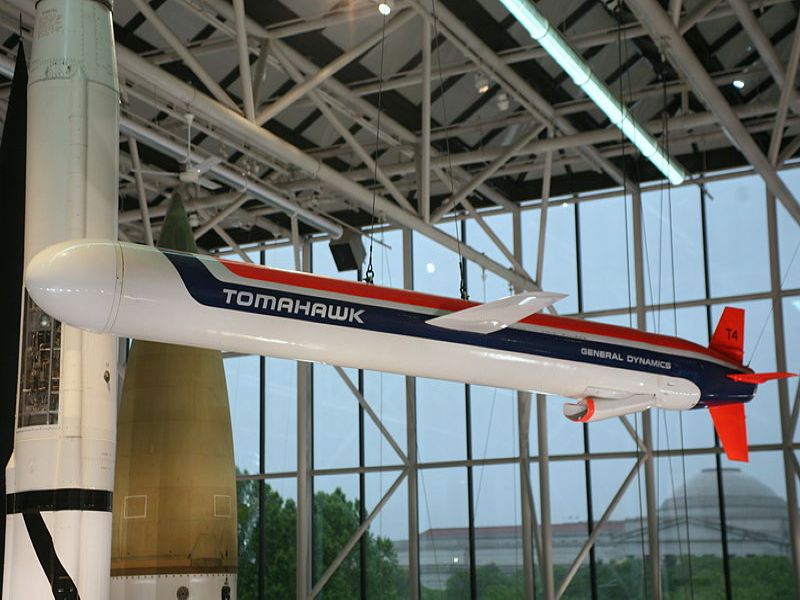
Tomahawk is a long-range, all-weather, subsonic cruise missile in service with the surface ships and submarines of the US and the UK’s Royal Navy. Originally produced by General Dynamics, Tomahawk is currently manufactured by Raytheon.
The Tomahawk Land Attack Missile (TLAM) can strike high-value or heavily defended land targets. The Block II TLAM-A missile achieved initial operating capability in 1984. The missile was first deployed in combat during Operation Desert Storm in 1991.
Recommended White Papers
Spectrum Monitoring and Geolocation Systems
Principles of geolocation techniques, recommended buyers guides.
Secure messaging solutions for naval applications
Marine navigation systems, software and solutions , tomahawk missile variants.
The Tomahawk family of missiles includes a number of variants, carrying different warheads. The UGM-109A Tomahawk (Block II TLAM-A) carries a W80 nuclear warhead.
RGM / UGM-109C (Block III TLAM-C) is a conventional unitary variant, carrying a 1,000lb-class warhead. RGM / UGM-109D (Block III TLAM-D) is a submunitions dispenser variant armed with 166 combined-effects bomblets.
RGM / UGM-109E Tomahawk (Block IV TLAM-E) is the latest member in the Tomahawk missile family. It carries a 1,000lb-class unitary warhead for a maximum range of 900nmi.
The Tomahawk Block IV missiles were converted and upgraded to Block V in 2017. The upgraded Tomahawk includes extended range, enhanced navigation and communication systems and modernised data-link radio.
The upgrades were performed at Raytheon’s Tucson, Arizona facility. The US Navy will use the upgraded Tomahawk cruise missiles beyond 2040. Raytheon was contracted to integrate the upgraded navigation and communication systems into the Block IV Tactical Tomahawk (TACTOM) missile in March 2020. The upgraded version is known as the Block V TACTOM.
The Block Va variants will be named Maritime Strike and have the capability of hitting a moving target. The Block Vb will feature the Joint Multi-Effects Warhead System.
Tomahawk design features
The Tomahawk is designed to operate at very low altitudes while maintaining high-subsonic speeds. Its modular design enables the integration of numerous types of warheads, guidance and control systems.
The missile carries a nuclear or conventional payload. It can be armed with a nuclear or unitary warhead or a conventional submunitions dispenser with combined-effect bomblets. The missile has a 5.56m length, 51.8cm diameter and a 2.67m wingspan. The weight of the missile is 1,315kg. It has a life span of 30 years.
The Tomahawk weapon system includes the Tomahawk missile, Theatre Mission Planning Centre (TMPC) / Afloat Planning System and the Tomahawk weapon control system (TWCS) for surface vessels or combat control system (CCS) for submarines.
Guidance and control
The Tomahawk Block IV uses GPS navigation and a satellite data-link to continue through a pre-set course. The missile can be reprogrammed in-flight to a new target.
The two-way satellite communications are used to perform post-launch mission changes throughout the flight. The on-board camera provides imagery of the target to the commanders before the strike.
The guidance system is assisted by Terrain Contour Matching (TERCOM). The Digital Scene Matching Area Correlation (DSMAC) system or GPS provide terminal guidance.
The Tactical Tomahawk Weapons Control System (TTWCS) integrated within the ship’s systems computes the path to engage targets. The system enables the planning of new missions on board the launch vessel. TTWCS is also used to communicate with multiple missiles for reassigning the targets and redirecting the missiles in flight.
The Block IV Tomahawk missile is outfitted with advanced electronic support measure (ESM) seeker in Block IV Tomahawk missile. Its joint multi-effects warhead enables the commander to control the blast.
The Tomahawk Block IV missile is powered by a Williams International F415 cruise turbo-fan engine and ARC MK 135 rocket motor. The propulsion provides a subsonic speed of 880km/h.
Tomahawk launch platforms
The missile can be launched from over 140 US Navy ships and submarines and Astute and Trafalgar class submarines of the Royal Navy. All cruisers, destroyers, guided missile and attack submarines in the US Navy are equipped with a Tomahawk weapons system.
US Navy launch platforms were modified to accommodate upgraded Tomahawk missile variants. Four Ohio class nuclear ballistic missile submarines were converted into cruise missile submarines for firing Tomahawk missiles. The Virginia class submarines and the Royal Navy Astute class submarines were also fitted with new vertical launch modules for Tomahawk missile.
Tomahawk orders and deliveries
The US signed a foreign military sales (FMS) agreement with the UK in 1995 to supply 65 Tomahawks for use with the Royal Navy nuclear submarines. The first batch of missiles was delivered in 1998.
The US Government approved an agreement in 2003 to deliver 65 Tomahawk Block IV missiles for the UK. In August 2004, the US Navy placed a $1.6bn multi-year procurement contract with Raytheon for 2,200 Tomahawk Block IV missiles.
Raytheon was awarded a $346m production contract for 473 Tomahawk Block IV cruise missiles in March 2006. The contract includes 65 submarine torpedo tube-launched missiles for the Royal Navy. The Block IV entered service with the Royal Navy in March 2008.
Raytheon was awarded a $207m-worth firm-fixed-price contract in March 2009 for 207 Tomahawk Block IV All-Up-Round (AUR) missiles.
The 2,000th Tomahawk Block IV missile was delivered to the US Navy in February 2010.
The US Navy placed a $338m contract with Raytheon in June 2012 for the delivery of 361 Tomahawk Block IV tactical cruise missiles. Another contract worth $254.6m was awarded for Tomahawk Block IV in the same year.
Raytheon delivered the 3,000th Tomahawk Block IV to the US Navy in January 2014 as part of the ninth Block IV production contract.
The US Navy awarded a $251m contract to Raytheon for the production and delivery of Tomahawk Block IV missiles for both the US Navy and Royal Navy in September 2014.
A $25.9m contract for Tomahawk missile composite capsule launching systems (C/CLS) was awarded in December 2014. The C/CLS is integrated with the nuclear-powered fast-attack submarines and nuclear-powered guided-missile submarines, allowing the missile to be launched from submarines.
Tomahawk Block IV missile demonstrated its moving target capability in tests conducted in February 2015.
Raytheon received a $122m contract from the US Navy in March 2015 for the production of 114 Tomahawk Block IV all-up round missiles. Raytheon conducted an active seeker test flight for the Tomahawk Block IV cruise missile in January 2016.
The 4,000th Tomahawk Block IV missile was delivered to the US Navy in August 2017. The US Navy warships and submarines launched 66 GPS-enabled Tomahawk missiles at Syrian chemical weapon facilities in 2018.
Raytheon planned to undertake recertification and modernisation programmes for Tomahawk Block IV missile in 2019 to add maritime strike capability and multiple-effects warhead upgrades to the missiles.
Raytheon received a $349m contract for phase two of the Maritime Strike Tomahawk Rapid Deployment Capability to improve the Tomahawk cruise missile system in August 2019. Work will be executed in various locations across the US until February 2023.
Related Projects
More Projects
Marine structures: marine structural design, materials and components , underwater acoustics: systems, communications and positioning solutions, naval communications systems, solutions and suppliers, sign up for our daily news round-up.
Give your business an edge with our leading industry insights.
Sign up to the newsletter
Your corporate email address.
Naval Technology In Brief
Global Defence Technology
Thematic Take
I consent to Verdict Media Limited collecting my details provided via this form in accordance with Privacy Policy
Thank you for subscribing
View all newsletters from across the GlobalData Media network.
This Is Not Your Father’s Tomahawk Cruise Missile
The new Block V can run down enemy ships and blast them with a half-ton high explosive warhead.
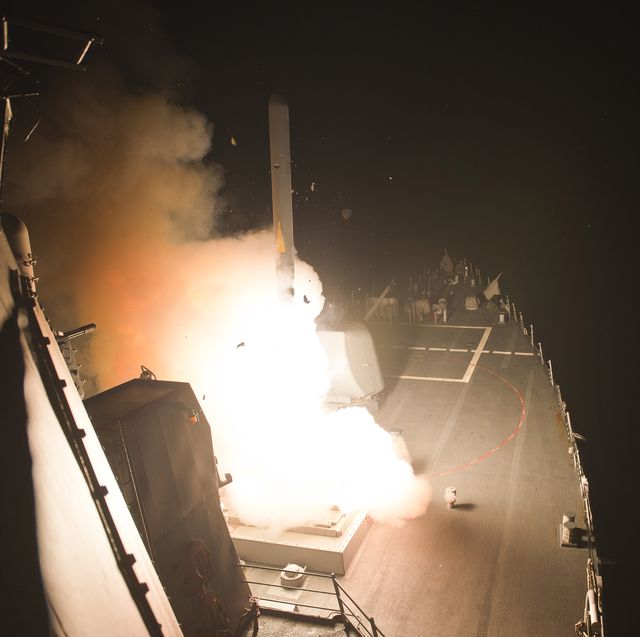
Gear-obsessed editors choose every product we review. We may earn commission if you buy from a link. Why Trust Us?
- The new missiles can attack enemy ships at sea or land targets with a new multi-effect warhead.
- The Tomahawk design is nearly half a century old but with the help of rolling upgrades has remained a viable weapon system.
The Tomahawk cruise missile, one of the oldest missiles in U.S. military service, is set to receive a new set of capabilities designed to help keep potential enemies in check.
➡ You love badass military tech. So do we. Let's nerd out over it together.
The missile’s new Block V configuration will include both new anti-shipping and land attack variants, boosting the capabilities of the U.S. Navy surface warships that carry them.
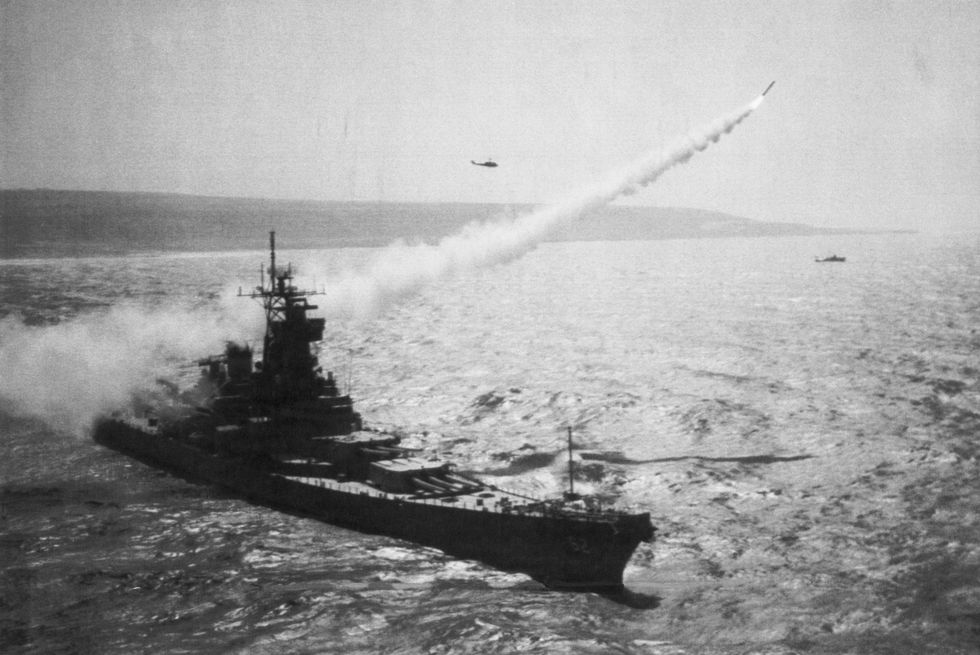
The Tomahawk is one of the most effective missiles in the Pentagon’s history. The missile, which General Dynamics first designed in the 1970s, was one of the first truly effective cruise missiles. Unlike traditional missiles that use rocket motors, fly high altitudes, and travel at Mach 2+ speeds, cruise missiles use turbojet engines, fly at low altitudes, and travel at subsonic speeds.
Most missiles are designed to sprint to their targets; Tomahawk is designed to run a marathon. Engineers chose a liquid fuel-sipping turbojet engine because it enabled greater range than a rocket engine of roughly the same size. A slower speed also makes low altitude flight more viable, which in turn makes the missile much more difficult to detect by radar. Today, most advanced countries operate similar low-flying subsonic missiles, including Russia, China, France, and South Korea.

Despite its age, the Tomahawk has stayed in the game through a series of progressive upgrades. The original Block I version included both nuclear-tipped and anti-ship versions of the missile. Block II introduced land attack capabilities, like those demonstrated during the 1991 Gulf War, with missiles striking Iraqi Air Force airfields and daytime targets across the Iraqi capital of Baghdad. Block III added GPS, eliminating a time-consuming programming system that required 80 hours to plot a missile’s course as well as a loitering capability.
Block IV Tomahawks added more features, including the ability to be re-routed to new targets in mid-flight. Block IV missiles also feature a camera and datalink, allowing a missile to send imagery back to friendly forces. If a Tomahawk discovers its target already struck or civilians are crowding the target area, the missile can be re-routed to destroy something else.
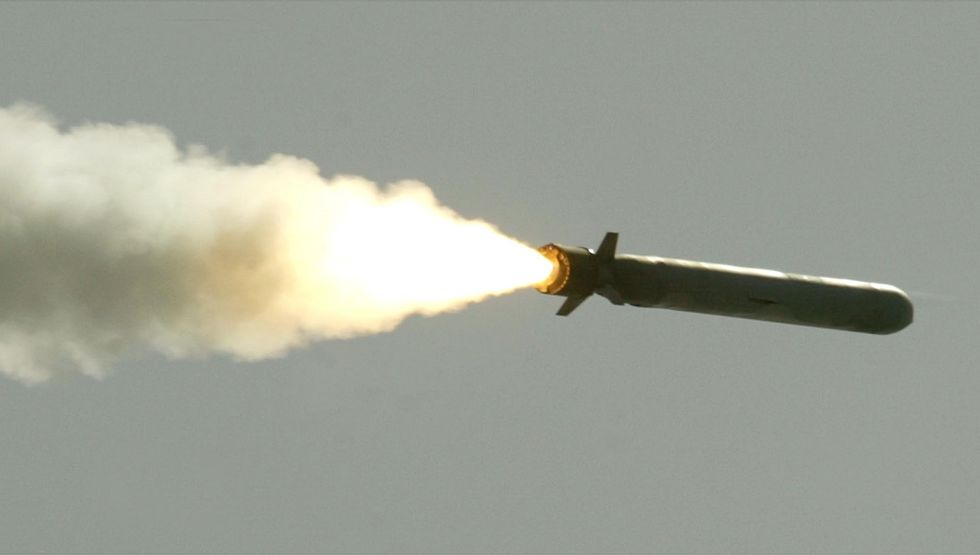
Now, Block V is where it gets really interesting.
The newest variant adds upgraded navigation and communications gear to older Tomahawks, electronics that, according to Defense News , make it easier to work through electronic warfare jamming and more difficult for enemy radars to detect. That’s important, because once detected, subsonic cruise missiles are relatively easy to shoot down. Block V then forks into two missiles, Block Va and Block Vb.
The Coolest Military Toys
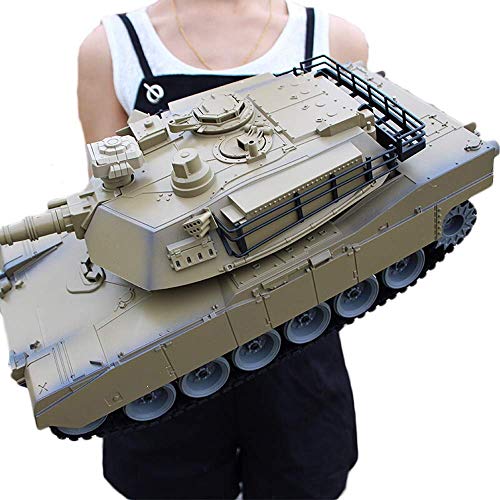
GRTVF 1:18 Scale RC Tank German Tiger Panzer

Tletiy Soviet T34 Mini RC Tank
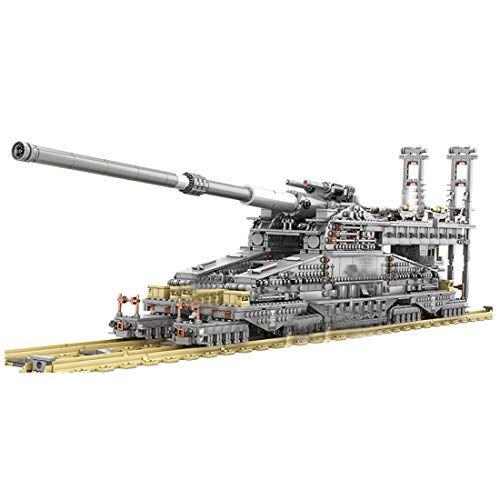
PeleusTech 3,846-Piece Model WWII German Dora Cannon

Big Bang 9-Inch 6F Light Field Vintage Cannon
Block Va essentially turns the cruise missile into an anti-ship missile. Also known as Maritime Strike Tomahawk, Block Va adds a seeker kit, including sensor, giving it the ability to strike moving targets at sea at ranges in excess of 1,000 miles. It’s not clear if Block Va can still strike land targets.
Block Vb is more oriented toward striking land targets with the new Joint Multiple Effects Warhead (MEWS). The weapon is a bit mysterious, but it seems to be a 1,000-pound warhead capable of striking both surface and underground hardened targets, including “integrated air defense systems and weapons of mass destruction” .
The great thing about Block V is that, unlike the Navy’s current anti-ship missile, it doesn’t need separate launchers. Block Vs will fit in any Mk. 41 vertical launch system silo—the same silo that currently carries Standard anti-air missiles, the SM-3 missile interceptor, Evolved Sea Sparrow interceptor missiles, and vertical launch anti-submarine rockets.
Today’s guided missile cruisers carry 122 silos, while destroyers carry between 90 and 96 silos. Theoretically, a cruiser could carry up to 122 Block Va missiles, though a more rounded mix of all of the above is preferred. Block V will also arm U.S. Navy submarines.
Like a lot of weapons in America’s arsenal, the Tomahawk missile is old—at least in concept. What started out as a nuclear-capable missile can now hunt down warships at 1,000 miles and attack hardened underground targets. The missile’s ability to adapt with the times, take on new roles, and reinvent itself means it will be a potent weapon system for easily another decade to come.
Now Watch This:
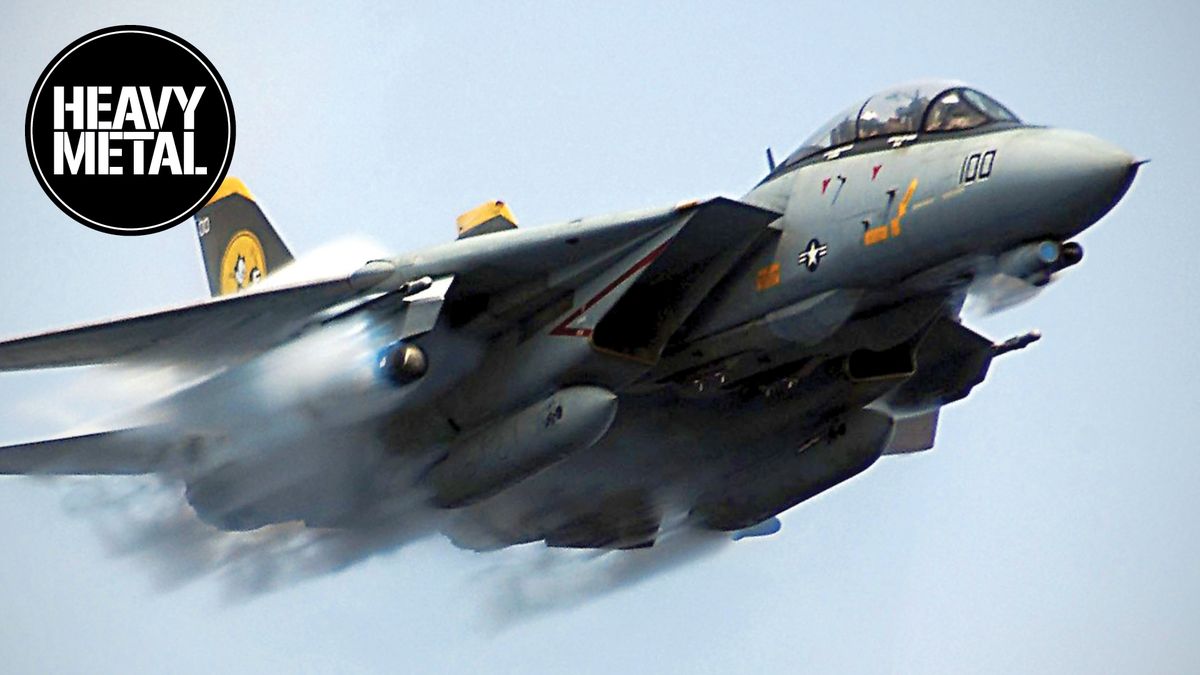
Kyle Mizokami is a writer on defense and security issues and has been at Popular Mechanics since 2015. If it involves explosions or projectiles, he's generally in favor of it. Kyle’s articles have appeared at The Daily Beast, U.S. Naval Institute News, The Diplomat, Foreign Policy, Combat Aircraft Monthly, VICE News , and others. He lives in San Francisco.
.css-cuqpxl:before{padding-right:0.3125rem;content:'//';display:inline;} Weapons .css-xtujxj:before{padding-left:0.3125rem;content:'//';display:inline;}
How Russia Copied America’s Deadliest Missile

The Air Force’s Upcoming “Doomsday Plane” Replacem

Meet the Marines' New Kamikaze Drone

Did Russia Launch a Weapon Near a U.S. Satellite?

America's Missile Defense Has Entered a New Era

Challenger 3 Tank Must Address the Harsh Truths

Russia Is Now Using Golf Carts in Combat

The Bradley Gets a New Iron Fist

Can the Army’s New Rifle Take on Russian Armor?
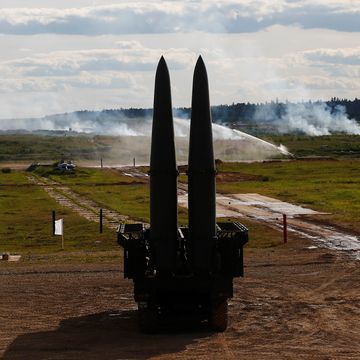
Russia's Unprecedented Nuclear Drills

Ukraine Is Using an Ancient Weapon on Russia
- Missiles of the World
- The United States
Tomahawk at a Glance
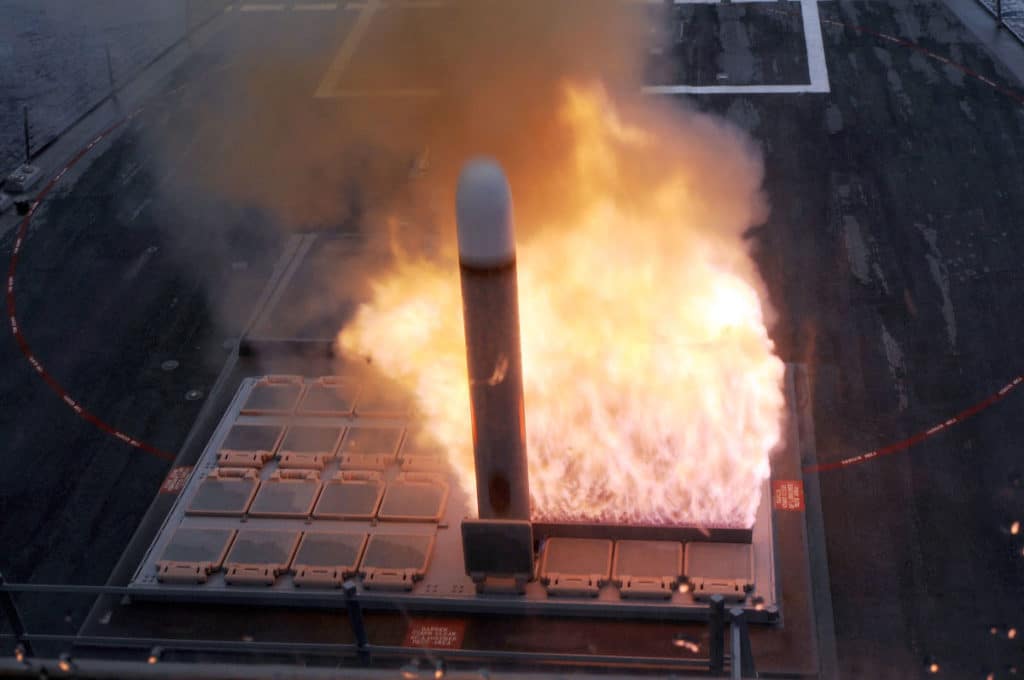
Tomahawk Development
The U.S. Navy began its development of sea-launched cruise missiles in 1972. 2 The Tomahawk was designed to fly at subsonic speed while maintaining a low altitude, making it difficult to detect on radar. It uses tailored guidance systems to maneuver while at such low elevations.
There were three original Tomahawk designs, the nuclear-tipped TLAM-N, the ground-launched Gryphon, and the conventional TASM.
BGM-109G Gryphon
In late 1970s, the U.S. Navy sought a precision land attack cruise missile capable of a much smaller CEP. Two Block II versions were produced; the TLAM-C and the TLAM-D.
Service History
The Tomahawk was first deployed in combat in the 1991 Gulf War in Operation Desert Storm, with the first salvo launched from the USS Paul F. Foster (DD 964) at Iraqi targets. 18 Overall, the mission achieved initial success.
However, before GPS guidance was implemented, the Tomahawk faced serious navigation issues in 2003’s Operation Iraqi Freedom. Due to the indistinct desert terrain in region, the missile’s TERCOM system was not adequate to guide the missile to its targets in Iraq. 19 Approximately ten Tomahawks drifted off course and crashed (”clobbered”) into the ground in Turkey, Saudi Arabia, and Iran in the initial phase of Iraqi Freedom. 20
- “Tomahawk Cruise Missile,” United States Navy Fact File, August 14, 2014, http://www.navy.mil/navydata/fact_display.asp?cid=2200&tid=1300&ct=2
- “Tomahawk Cruise Missile,” United States Navy Fact File, August 14, 2014, http://www.navy.mil/navydata/fact_display.asp?cid=2200&tid=1300&ct=2.
- Sam LaGrone, “West: U.S. Navy Anti-Ship Tomahawk Set for Surface Ships, Subs Starting in 2021,” USNI News , February 18, 2016, https://news.usni.org/2016/02/18/west-u-s-navy-anti-ship-tomahawk-set-for-surface-ships-subs-starting-in-2021.
- “Tomahawk Long-Range Cruise Missile,” Naval Technology, http://www.naval-technology.com/projects/tomahawk-long-range-cruise-missile/.
- “RGM/UGM-109 Tomahawk,” in IHS Jane’s Weapons: Strategic 2015-2016, ed. James C. O’Halloran (United Kingdom: IHS, 2015), 219-223.
- “General Dynamics/McDonnell Douglas BGM-109G Gryphon” National Museum of the Air Force, April 26, 2011.http://www.nationalmuseum.af.mil/factsheets/factsheet.asp?id=18194.
- Missile Defense Project, “Tomahawk,” Missile Threat, Center for Strategic and International Studies, September 19, 2016, last modified June 15, 2018, https://missilethreat.csis.org/missile/tomahawk/ .
- Fuller, Malcolm. “Tomahawk/RGM/UGM-109B/C/D/E” Jane’s Weapons: Naval. December 17, 2012.
- Department of the Navy, Naval Vessel Historical Evaluation – Paul F. Foster Final Determination (Washington, DC: 2013), https://www.navsea.navy.mil/Portals/103/Documents/TeamShips/SEA21/InactiveShips/Historic/2013/EDD964-Paul-F.-Foster-Final-DOI.pdf.
- “The Tomahawk Missile’s First Mission Was Over…Iran?,” War on the Rocks, April 6, 2015, https://warisboring.com/the-tomahawk-missile-s-first-mission-was-over-iran/.
- Jeffrey Lewis, ”Why the Navy Should Retire TLAM-N,” Arms Control Wonk (blog), December 13, 2009, https://www.armscontrolwonk.com/archive/202560/why-the-navy-should-retire-tlam-n/.
- “What is a Tomahawk Missile?” History.com, April 7, 2017, https://www.history.com/news/what-is-a-tomahawk-missile.
- NBC News, “U.S. Launches Missiles at Syrian Base Over Chemical Weapons Attack,” NBC News, April 7, 2017, http://www.nbcnews.com/news/us-news/u-s-launches-missiles-syrian-base-after-chemical-weapons-attack-n743636.
- Air Warfare
- Cyber (Opens in new window)
- C4ISR (Opens in new window)
- Training & Sim
- Asia Pacific
- Mideast Africa
- The Americas
- Top 100 Companies
- Defense News Weekly
- Money Minute
- Whitepapers & eBooks (Opens in new window)
- DSDs & SMRs (Opens in new window)
- Webcasts (Opens in new window)
- Events (Opens in new window)
- Newsletters (Opens in new window)
- Events Calendar
- Early Bird Brief
- Digital Edition (Opens in new window)
US Navy set to receive latest version of the Tomahawk missile
WASHINGTON — Raytheon plans to deliver next week the first of the U.S. Navy’s new Block V Tomahawk , an upgraded version of the service’s venerable land-attack missile that will ultimately include the ability to target ships at sea at extended ranges.
The new Block V , when fully realized in its Block Va and Block Vb varieties, will be expected to hit surface ships at Tomahawk ranges — in excess of 1,000 miles — with the integration of a new seeker. It also will integrate a new warhead with a broader range of capabilities, including greater penetrating power.
Tomahawk’s range is especially important in the Asia-Pacific region, where China’s rocket force has extraordinary reach with its DF-26 and DF-21 missiles, with ranges of 2,490 and 1,335 miles respectively, according to the Center for Strategic and International Studies.
The U.S. Navy’s news missiles are destined not just for the vertical launching systems on surface ships but also on attack submarines that can more easily operate inside the range of China’s rocket force .
The Navy is expected to make a decision on the future of the Tomahawk weapon in 2021, but the signs seem to point to its continuation. The service has had a long-running search for a next-generation land-attack missile, but a recent analysis of alternatives led to the Navy restarting the Tomahawk line and upgrading its current inventory.
In the Navy’s 2021 budget documents submitted last year, the service said it had yet to determine the future of the missile. But in testimony before the House Armed Services Committee, the head of U.S. Indo-Pacific Command, Adm. Phil Davidson, specifically cited the anti-ship Maritime Strike Tomahawk specifically and the surface-strike variant of the SM-6 as capabilities needed by the Marine Corps in its quest to hold Chinese ships at risk from shore-based missiles.
“What the Marine Corps has asked for have already been developed in the [Navy] and is employed on Navy ships, things like Maritime Strike Tomahawk, SM-6. These are immediate capabilities that I think should be made available to the Marine Corps,” Davidson said.
Advances in missile technology might actually be helping the Tomahawk’s cause to stay in the Navy’s vertical launching system missile tubes longer, according to Bryan Clark, a retired submarine officer and senior fellow at the Hudson Institute.
A landing craft, utility lowers its ramp to unload a U.S. Marine Corps High Mobility Artillery Rocket System as part of a simulated amphibious raid on Okinawa in 2019. (Marine Corps photo by Lance Cpl. Joshua Sechser)
The combination of the SM-6, the new 100-plus-mile ranged anti-ship Naval Strike Missile bound for the littoral combat ships and next-generation frigate, and the Block V upgrades on Tomahawk will give the Navy’s weapons a place in the service’s vertical launching system cells for some time to come, Clark said in a December interview.
“Between Tomahawk Block V, the SM-6 and the NSM, the Navy has a collection of attack weapons that they are happy with,” he said, adding that a long-running effort to develop a next-generation land-attack weapon has lost some of its urgency.”
That means as hypersonic cruise missiles make developmental progress, the Navy will likely make do with its current generation of weapons instead of embarking on an expensive next-generation land-attack weapons program.
“What’s happening in parallel is in the development of hypersonic missile that are a smaller form factor than the boost-glide weapons that are coming to maturity now,” Clark said. “And if they can get it down to being able to fit in [the Mark 41], then that could provide the Navy a next-generation capability that is more survivable and has a shorter time of flight.
“So I think this combination of missiles the Navy has now, combined with the fact that the hypersonic weapons are coming along a little further out, means the Navy is going to stick with what it has potentially even longer than it had originally anticipated.”
David B. Larter was the naval warfare reporter for Defense News.
More In Naval
Top State Department official to become Austin’s new chief of staff
The decision puts to rest chollet's stalled nomination to take over the pentagon's top policy role..
Army to buy more than 1,000 Switchblade drones through Replicator
The army’s vice chief of staff, revealed the quantity for the first time during a june 21 house appropriations defense subcommittee hearing..
India advances light attack helicopter program with large tender
Armaments on the lch include mistral air-to-air missiles, up to four fz231 2.75-inch (70mm) rocket pods and a nose-mounted m621 20mm cannon..
Romania to buy 54 howitzers from South Korea’s Hanwha Aerospace
Other bidders reportedly included germany’s krauss-maffei wegmann with the panzerhaubitze 2000 and turkey's bmc with its t-155 fırtına..
Lawmakers urge Defense Innovation Unit to partner with Israel, Taiwan
The provisions call for diu to establish a “strategic partnership” with each country to coordinate on industrial priorities and dual-use tech development., featured video, what is auto loan refinancing, and should i consider it — money minute.
Retiring Old Guard Sentinel stands one final watch | Defense News Weekly Full Episode 6.22.24
Disney makes surprise donations at Fisher House locations
JADC2 and the evolution of a more efficient killchain
Trending now, when will china have a sixth-gen fighter jet, small drones will soon lose combat advantage, french army chief says, us to vacate first air base within weeks as it withdraws from niger, european gun makers trial small arms as drone stoppers, when will argentina receive its modernized tanks.
Advertisement
How Cruise Missiles Work
- Share Content on Facebook
- Share Content on LinkedIn
- Share Content on Flipboard
- Share Content on Reddit
- Share Content via Email
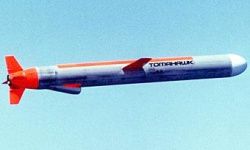
Tomahawk cruise missiles frequently appear in the news because they are the U.S. weapon of choice for a variety of quick-strike operations. With all of the missiles in the U.S. arsenal, have you ever wondered why cruise missiles seem to come up so often?
In this edition of HowStuffWorks , we will look at cruise missiles so that you can understand what they are, how they operate and why they are ideal for certain scenarios.

A cruise missile is basically a small, pilotless airplane . Cruise missiles have an 8.5-foot (2.61-meter) wingspan, are powered by turbofan engines and can fly 500 to 1,000 miles (805 to 1,610 km) depending on the configuration.
A cruise missile's job in life is to deliver a 1,000-pound (450-kg) high-explosive bomb to a precise location -- the target. The missile is destroyed when the bomb explodes. Since cruise missiles cost between $500,000 and $1,000,000 each, it's a fairly expensive way to deliver a 1,000-pound package.

Cruise missiles come in a number of variations (see the links at the end of the article for more information) and can be launched from submarines , destroyers or aircraft.
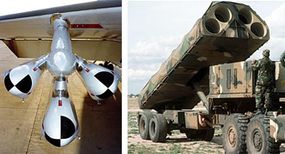
When you hear about hundreds of cruise missiles being fired at targets, they are almost always Tomahawk cruise missiles launched from destroyers.

Cruise missiles are 20 feet (6.25 meters) long and 21 inches (0.52 meters) in diameter. At launch, they include a 550-pound (250-kg) solid rocket booster and weigh 3,200 pounds (1450 kg).
The booster falls away once it has burned its fuel. The wings, tail fins and air inlet unfold, and the turbofan engine takes over.
This engine weighs just 145 pounds (65 kg) and produces 600 pounds of thrust burning RJ4 fuel. The fuel load is 800 to 1,000 pounds (about 450 kg) of fuel at launch, or approximately 150 gallons (600 liters). The missile has a cruising speed of 550 mph (880 kph).
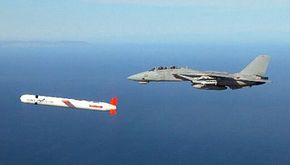
The hallmark of a cruise missile is its incredible accuracy. A common statement made about the cruise missile is, "It can fly 1,000 miles and hit a target the size of a single-car garage." Cruise missiles are also very effective at evading detection by the enemy because they fly very low to the ground (out of the view of most radar systems ).
Four different systems help guide a cruise missile to its target:
- IGS - Inertial Guidance System
- Tercom - Terrain Contour Matching
- GPS - Global Positioning System
- DSMAC - Digital Scene Matching Area Correlation
The IGS is a standard acceleration-based system that can roughly keep track of where the missile is located based on the accelerations it detects in the missile's motion ( click here for a good introduction). Tercom uses an on-board 3-D database of the terrain the missile will be flying over. The Tercom system "sees" the terrain it is flying over using its radar system and matches this to the 3-D map stored in memory. The Tercom system is responsible for a cruise missile's ability to "hug the ground" during flight. The GPS system uses the military's network of GPS satellites and an onboard GPS receiver to detect its position with very high accuracy.
Once it is close to the target, the missile switches to a "terminal guidance system" to choose the point of impact. The point of impact could be pre-programmed by the GPS or Tercom system. The DSMAC system uses a camera and an image correlator to find the target, and is especially useful if the target is moving. A cruise missile can also be equipped with thermal imaging or illumination sensors (as used in smart bombs ).
Frequently Asked Questions
How do cruise missiles navigate to their target, what advancements have been made in cruise missile technology, lots more information, related articles.
- How Stinger Missiles Work
- How Sidewinder Missiles Work
- How Smart Bombs Work
- How MOAB Works
- How Patriot Missiles Work
- How Stealth Bombers Work
- How Apache Helicopters Work
- How F-15s Work
- How Airplanes Work
- How Gas Turbine Engines Work
- How Radar Works
- How GPS Receivers Work
- How Rocket Engines Work
More Great Links
- USAF Fact Sheet: AGM-86B/C Missiles
- U.S. navy Fact File: Tomahawk Cruise Missile
- BBC News: NATO's firepower: The cruise missile
- Time.com: Tomahawk Cruise Missile
- Analysis: Tomahawks, Submarines and the F-111
Launch systems
- Arleigh Burke Class (AEGIS) Guided Missile Destroyers, USA
- SSN Los Angles Class Attack Submarine, USA - U.S. subs that launch cruise missiles
- SSN Astute Class Attack Submarine, UK - Royal Navy subs that launch cruise missiles
- B-52H Stratofortress Long-Range Multi-Role Bomber, USA
- B-2 Spirit Stealth Bomber, USA
Miscellaneous
- Williams F107-WR-101 Turbofan Engine
- Digital Imagery Workstation Suite (DIWS) - generates the Digital Scene Matching Area Correlation (DSMAC) reference scenes
Please copy/paste the following text to properly cite this HowStuffWorks.com article:

- History Classics
- Your Profile
- Find History on Facebook (Opens in a new window)
- Find History on Twitter (Opens in a new window)
- Find History on YouTube (Opens in a new window)
- Find History on Instagram (Opens in a new window)
- Find History on TikTok (Opens in a new window)
- This Day In History
- History Podcasts
- History Vault
What Is a Tomahawk Missile?
By: Martin Stezano
Updated: August 30, 2018 | Original: April 7, 2017

History of the Tomahawk cruise missile

The Tomahawk Land Attack Missile (TLAM) is an American-developed weapon classified as a cruise missile, which is an unmanned jet-propelled aircraft that uses guidance systems to seek and destroy targets.
The missiles are approximately 21 feet long, weigh 1.5 tons and can be launched from both traditional torpedo tubes and vertical launch tubes on modern submarines. Once the Tomahawk is in the air, the turbojet engine kicks in and its wings spread, allowing it to reach speeds of 500 miles per hour.
The sophisticated guidance system uses a combination of GPS, TERCOM (Terrain Contour Matching) and DSMAC (Digital Scene-Matching Area Correlator) to ensure the missile accurately destroys its target. TERCOM uses radar signals, while DSMAC uses optical images stored in the electronic system. As it closes in on its target, the missile drops to an altitude of 100 feet or less before impact. In layman’s terms, this type of missile is designed to be used at great distances, with pinpoint accuracy, minimizing risk to personnel and civilians.
What sets the Tomahawk apart from other types of munitions is that combination of size, speed, distance and trajectory. Traditional saturation bombing–in which hundreds of bombs are dropped from a plane–is powerful, but not accurate. Saturation bombing also requires the use of a pilot and crew, which endangers personnel. Ballistic missiles, like the Scud, can travel greater distances at faster speeds, but require much bigger launching pads and a lot more fuel, meaning they can’t be used as covertly The Tomahawk is smaller and flies lower than other missiles, making them harder to detect and intercept.
Development of what would become the Tomahawk began in the 1940s, but the emergence of the Polaris ballistic missile program led to its shelving. Technological advances made it possible for the missile to be revisited in the 1970s, and the new weapon was introduced by defense contractor McConnell Douglas in 1983.
Initially, there were three types of Tomahawk missile: an anti-ship one with conventional warheads, and two land-attack versions with either nuclear or conventional warheads attached. Today, only the land-attack, conventional non-nuclear version is in use. Improvements have been made on the original design, and today’s more accurate and more powerful versions are manufactured by Raytheon.
The Tomahawk Missile in Use

The Tomahawk made its debut in live combat during the Persian Gulf War in 1991. On January 17, the USS Paul F. Foster launched the first Tomahawk missile, and nearly 300 additional missiles were launched from U.S. Navy ships and submarines in subsequent days of the conflict. The new weapon proved instrumental in bringing a swift end to the war.
Production of the missile ramped up after that, and hundreds of Tomahawks were used throughout the 1990s. On December 16, 1998, 415 missiles were fired at Iraqi targets during Operation Desert Fox, after Saddam Hussein refused to abide by United Nations-mandated inspections. They were also used by NATO forces in early 1999, during Operation Allied Force operations against targets in Serbia and Montenegro. More than 800 Tomahawks were launched during the 2003 invasion of Iraq, and other successful deployments include Afghanistan, Somalia and Libya.
Use of the missile has not been without controversy. On December 17, 2009, 41 civilians–mostly women and children–were killed by missiles targeting an alleged Al-Qaeda training camp in Yemen. Although U.S. and Yemeni government officials initially denied responsibility, an investigation by Amnesty International—and revelations by WikiLeaks—eventually concluded that the missiles had been American Tomahawks launched from a naval vessel.

Sign up for Inside History
Get HISTORY’s most fascinating stories delivered to your inbox three times a week.
By submitting your information, you agree to receive emails from HISTORY and A+E Networks. You can opt out at any time. You must be 16 years or older and a resident of the United States.
More details : Privacy Notice | Terms of Use | Contact Us
- Terms of Use

War News | Military History | Military News
Tomahawk missiles: a modular, incredibly accurate and brutally lethal weapon.
- War Articles
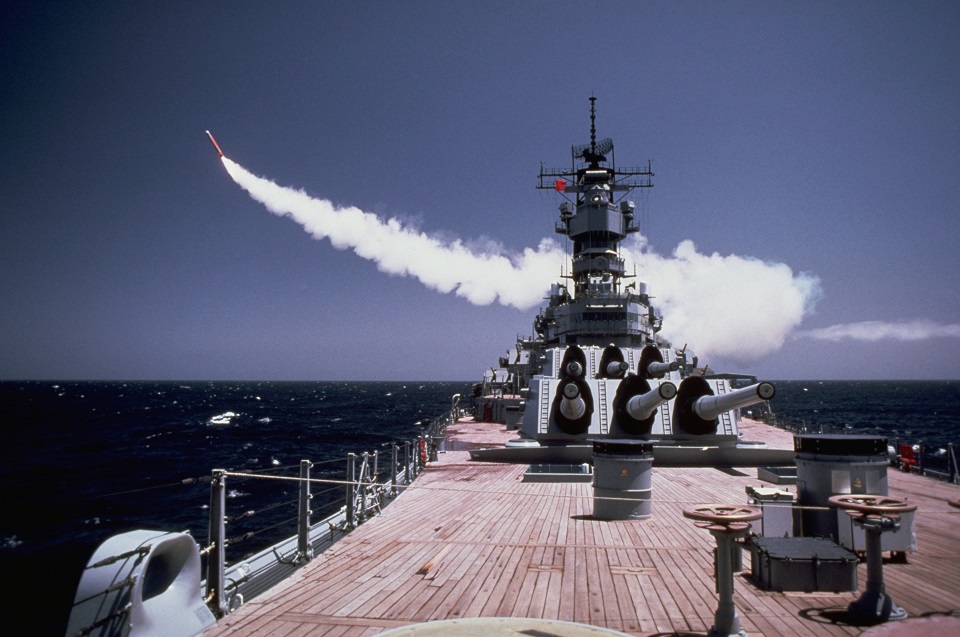
The Tomahawk missile first joined the US Navy fleet in 1983 and following multiple recertifications, has continued to be an integral weapon for ship and submarine-based land-attack operations. Although it has been frequently employed since its creation, the Tomahawk missile is most notable for its use in the Persian Wars .
Tomahawk Missile’s Feature Some Incredible Capabilities
Priced at approximately $1 million apiece , the Tomahawk missile packs a major punch. It can reach a speed of up to 550 miles per hour, reach a distance of 700 to 1350 nautical miles depending on which variant of the missile is fired, and successfully reach its target even in heavily defended air space.

The missile can carry 160 bomblets, a 1,000-pound conventional warhead, or a W80 nuclear warhead. Using GPS, inertial navigation, and terrain contour matching, the Tomahawk has the ability to hit within ten yards of its intended target. It can also perform evasive maneuvers at extremely low altitudes, allowing it to take out diverse targets and do so without causing much collateral damage.
Tomahawk Missiles are built for Mods
The physical look of the weapon is intended to resemble a “flying torpedo”, which it does nicely. The look of the missile has remained pretty much the same since its beginning. The slim design allows the missile to be compatible with vertical launchers on surface warships as well as torpedo tubes on submarines .
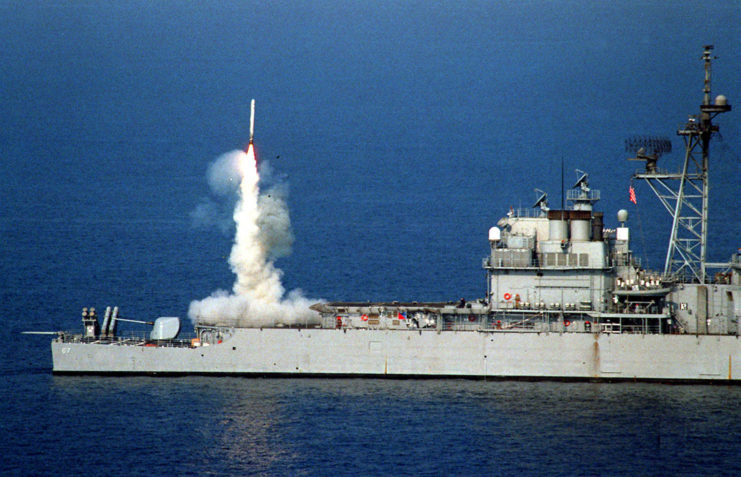
The overall shelf life of the missile is 30 years and requires recertification at the time of expiration. Recertification allows ample opportunity to apply modifications to the missile that increase its lethality while also ensuring that the missile is still ready for combat.
The Tomahawk missile was built with a modular design, which makes internal modifications and upgrades relatively simple. Specifications that work efficiently can remain in the missile, while specifications that need to be replaced are done so without affecting the rest of the internal makeup of the missile.
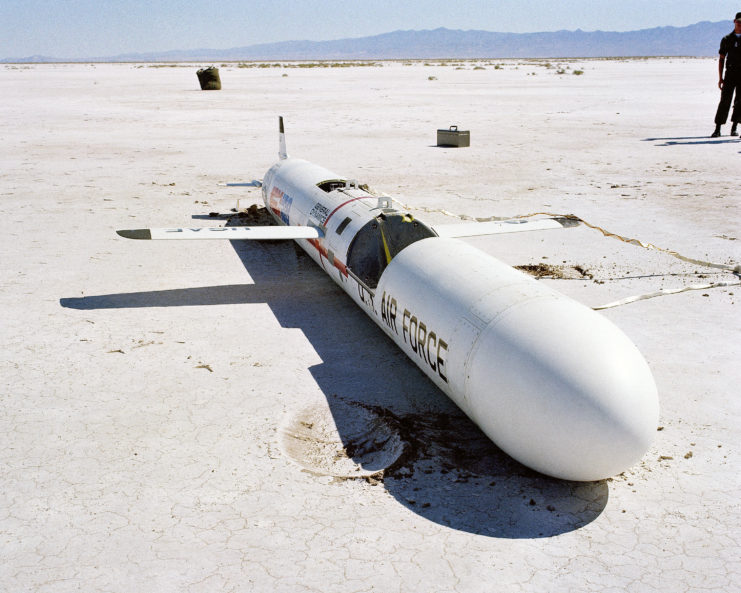
Block Va/Vb
Block Va allows this variant of the Tomahawk to strike moving targets at sea. It has a new seeker that is capable of accurately identifying and targeting warships as far as 1,000 miles away. This variant brings the US Navy up to speed with Russian and Chinese adversaries that were already equipped with long-range anti-ship munitions.
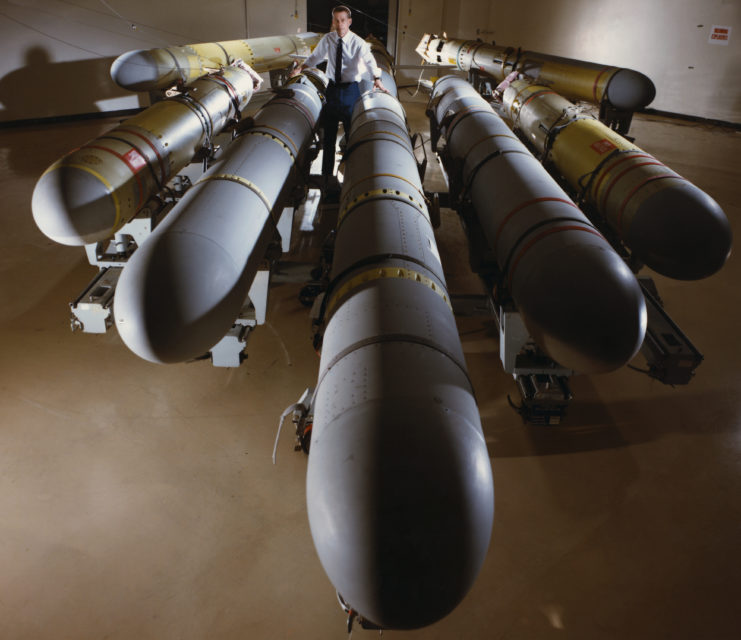
Block Vb has a joint multi-effects warhead that allows the Tomahawk to hit more diverse land targets. It is a hard-target kill variant that is capable of destroying densely-constructed enemy assets which previously would have required more specialized munitions.
International interest
Beyond its use by the US, the Tomahawk missile has also been used by the United Kingdom’s Royal Navy in a number of operations, and now all Royal Navy fleet submarines are Tomahawk missile capable. Additionally, there had previously been expressed interest in acquiring the missile by countries like Spain, the Netherlands, Canada, and Australia, though many had not followed through with their orders.

Subscribe Button

Exclusive Content
The Tomahawk Cruise Missile: Subsonic Long-range, all-weather weapon
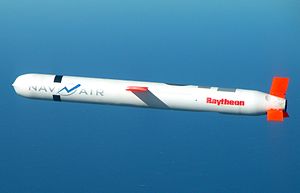
A major improvement to the Tomahawk is network-centric warfare-capabilities, using data from multiple sensors (aircraft, UAVs, satellites, foot soldiers, tanks, and ships) to find its target. It will also be able to send data from its sensors to these platforms. It will be a part of the networked force being implemented by the Pentagon.
In response to a deadly chemical attach, they recently were used in a missile strike against Syrian, approximately 60 U.S. Tomahawk missiles hit the Shayrat air base, southeast of Homs, a small installation with two runways, where aircraft often take off to bomb targets in northern and central Syria. The U.S. missiles hit at 3:45 a.m. (0045 GMT) Friday morning and targeted the base’s airstrips, hangars, control tower and ammunition areas.
Weight: 2,900 lb. 3,500 lb with booster
Length: Without booster: 18 ft 3 in. (With booster: 20 ft 6 in).
Diameter: 20.4 in.
Warhead: Multiple package capable including Nuclear W80 warhead. Conventional: 1,000 pounds High explosive or Submunitions dispenser with BLU-97/B Combined Effects Bomb or PBXN.
Detonation mechanism: FMU-148 since TLAM Block III, others for special applications
Engine: Williams International F107-WR-402 turbofan using TH-dimer fuel and a solid-fuel rocket booster.
Featured Video

- Spitfire: The Plane that Saved the World
- 17 Most Bizarre Aircrafts

Don’t Miss

Profile Form
Profile Data

- Digital + Print Edition
- Digital Edition
- Gift Subscription
- Customer Service Portal
- Help – Contact Us
- Looking For Contributors
- Career Opportunities
ADVERTISE WITH US
- Flightjournal Membership Login
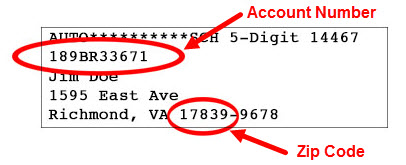
Forgot your password?
Lost your password? Please enter your email address. You will receive mail with link to set new password.
Back to login
- Aviation Stories
- Restoration and Reproduction
- Personalities
- Aviation Museum Directory
- Report an Issue
- Digital + Print
- Digital Edition Login
- Free newsletter
- Newsletter Sign Up
- Contributors’ Guidelines
- Privacy Policy
- Terms of Use
- Licensing and Permission
おトクにキレイになる情報が満載!
- 【ためるチャレンジ】ボーナスコインGET N
- 【スタンプカード】毎日押して大量コイン☆ N
- 【プレゼント】コインが当たる! N
- 【すごろく】1位で必ず1万円分のコイン★ N
navalpost.com
- 7,235円(税込)以上の お買い物で送料無料
- シャツ/ブラウス(長袖/七分)
メンテナンスのお知らせ | 新お買い物特典プログラム

レディースLE CIEL BLEU ルシェルブルー セットアップ ブラック
※ 商品のお届けについては こちら よりご確認ください。
SHOPPING が販売、発送いたします。
当日発送可 (14:00までのご注文が対象)
- ※ ご注文内容・出荷状況によっては当日発送できない場合もございます。 詳しくは こちら よりご確認ください。
- ※ ポストにお届け / 一点のみ購入でご利用可能です。 ゆうパケットでのお届けの場合はサンプル・ノベルティが対象外となります。 ゆうパケットには破損・紛失の保証はございません。 詳しくは こちら よりご確認ください。

- トップスの商品一覧を見る
- レディースの商品一覧を見る

ダイヤモンドルース【特別価格】0.37ct ペアシェイプカット ダイヤ ルース 裸石 天然 ダイヤ
LE CIEL BLEU

ロングワンピース/マキシワンピース未使用【ALICE+OLIVIA】総レース 花柄 ドレスワンピース

スーツケース/キャリーバッグ無印良品 ハードキャリーケース 105L 新品ダグ付き

専用 ダイヤモンドクロスナイロン 2ショルダーバッグ

約9×195×2本体重量新品 フルラ FURLA 長財布 バビロン コンチネンタルウォレット チリエジャ/バレリーナ
このカテゴリのランキングをもっと見る
この商品を見ている人におすすめ

【新品未使用 タグ付き】エルメス ツイリー スカーフバンダナ/スカーフ

レディース専用★ ATON エイトン フーディーパーカー CACAO サイズ02

miumiuカチューシャ(クリスタルボウ付きヘッドバンド)アクセサリー

ひざ丈ワンピースbaby タータンチェックベビードールjsk ロリィタ
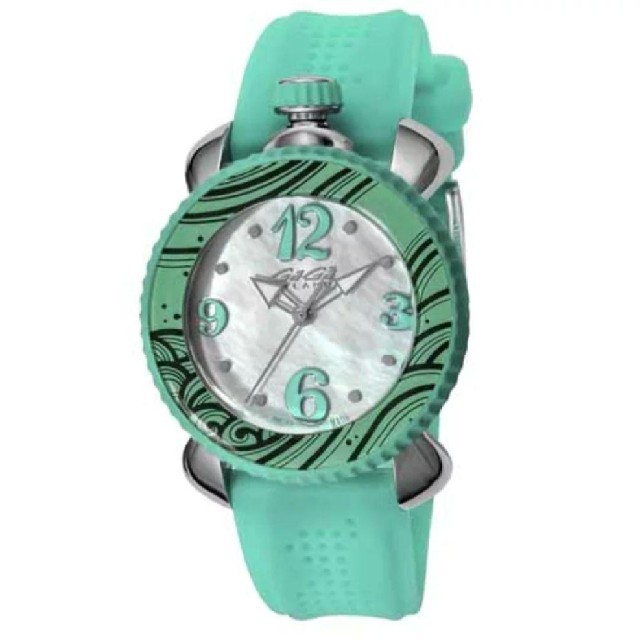
ガガミラノ 腕時計 レディース LADY SPORTS 40MM ホワイトパール702004サイズ

ファッション小物CHANEL メガネフレーム

道中着 身丈96.5cm 裄丈67cm 正絹 名品バイセル道中着

ステートオブエスケープSTATE OF ESCAPE バッグ

PAUL&JOE メイクポーチファッション小物

本体ナイロン100%裏面mame Water Repellent Nylon Hooded Coat

mamaさま◆未使用◆クリーム&ピンク◆花◆七五三◆入園入学式◆大きめ◆H卒業式

アクセサリーK18ダイヤ入りファッションリング(サイズ11号)

ルイ・ヴィトン パピヨン30ショルダーバッグ ショルダーバッグエベヌブラウン系

約132.8cm身幅IRENE ZIP UP JUMPER SKIRT

INORI4U着物リメイクワンピース オリジナルハイカラシャーリングドレス2点ハンドメイドワンピース

LIGHTONTIME品番STAR JEWELRYクリスマス限定腕時計 レディース

【1カラット】輝くモアサナイトダイヤモンド ネックレスモアサナイト

なしバレンチノガラバーニ ショルダーバッグ 黒

LAUREN MANOOGIANローレン マヌージアン L'Appartementアパルトモン別注2018 KNIT GOWNニットガウンコート【LKNA64225】ニット/セーター

約12cm×縦バレンシアガ BALENCIAGA ショッピングフォンホルダー 2WAYバッグ ショルダーバッグ レザー ブラック 593826 新入荷 OB1644
ヘルプ&ガイド
- ショッピングサービス利用規約
- 個人情報の取り扱いについて
- 特定商取引法に基づく表示
- 商品に関するお問い合わせ
- お問い合わせ(メンバー用)
SHOPPINGについて
への掲載・ビジネス活用

MBDA Unveils Land Cruise Missile – LCM – System for Deep Precision Strike
Mbda unveils the land cruise missile (lcm) system, a new ground-launched deep precision strike capability, to meet the needs of the new strategic environment on the battlefield..
Naval News Staff 19 Jun 2024
MBDA press release
The Land Cruise Missile (LCM) builds on all of MBDA ’s expertise in the field of Deep Precision Strike and is based on the combat-proven Naval Cruise Missile (NCM) in-service on French Navy frigates and attack submarines.
The LCM system constitutes a unique European sovereign solution for a deep strike ground-launched cruise missile system, designed, produced, and assembled in Europe. Customers operating NCM missiles and LCM systems will belong to an exclusive club of countries possessing very long-range Deep Precision Strike capability from below and from the surface of the sea as well as from the ground.
“ The Land Cruise Missile system complements MBDA’s comprehensive portfolio of decisive European sovereign solutions. Building on the track-record of the Naval Cruise Missile, MBDA demonstrates its ability to cover the full spectrum of operational requirements for our customers while generating synergies across our deep strike portfolio to ensure battle-readiness.” Eric Béranger, CEO of MBDA

The LCM system will offer the same unique capabilities as the NCM, including metric precision at very long range; high survivability when penetrating through enemy-integrated air defense systems thanks to reduced radar cross section & terrain-following capability; and high lethality against targets. It will also allow highly accurate synchronized time-on-target (STOT) capability as already demonstrated by the simultaneous NCM strike from a frigate and a submersed submarine , performed by the French Navy with the support of DGA in April 2024. The LCM brings the capability to inflect aggressive behaviors from peer adversaries by imposing a permanent and immediate threat against enemy high-value assets.
With the LCM concept of operation, MBDA will offer a comprehensive integrated system including the mission planning suite and ground launchers mounted on dedicated land platforms offering flexibility, survivability, and reactivity to ground forces in high-intensity contexts.
Naval News comments:
MBDA’s LCM could become a European equivalent to the Mid-Range Capability / Typhon system (based on the Tomahawk cruise missile) under development in the United States to fullfil a similar role: Deep precision strike. It is currently being tested and field with both the US Army and US Marine Corps .
Related Articles

Video: MBDA CEO on 2023 results, War Economy, Red Sea and Anti-Ship Missiles

Royal Navy’s Sea Viper to take on ballistic threats

Delivery of First MLU Aster 30 Munitions to France and Italy

Russia Freaked Out: Why the U.S. Navy 'Unretired' the Iowa-Class Battleships
Summary and Key Points: The Iowa-class battleships, built for WWII and reactivated in the 1980s under Reagan, were seen as cost-effective solutions to counter the Soviet naval threat, particularly the Kirov-class battlecruisers.
-The reactivation offered enhanced Naval Surface Fire Support (NSFS) and anti-ship capabilities with upgrades including Tomahawk and Harpoon missiles.
-Their reactivation was a strategic decision to bolster U.S. naval power against the Soviet buildup. However, with the Soviet Union's collapse, the battleships were retired in the early 1990s.
Reagan's Reactivation: The Return of Iowa-Class Battleships in the 1980s
Before the aircraft carrier became the most powerful ship afloat, hulking battleships ruled the waves. The last U.S. battleships, the Iowa class, were built for the Second World War and saw sporadic service in the decades that followed. Somewhat incredibly, they were retired for the final time in the early 1990s following a reactivation in the early 1980s.
Their return to service was hard-fought and is often questioned, but why did the Reagan administration push so hard to reactivate the Iowas?
Typically cited is their ability to handle the Soviet Kirov-class battlecruisers that were first launched in the early 1980s. Their role as Naval Surface Fire Support (NSFS) vessels also played a part in their return to service. Additionally, refitting and crewing the four Iowas was deemed more cost-effective than ramping up production of new ships – Congress and the U.S. Navy at the time assessed they would get more bang for their buck by activating the old battleships in their effort to match the Soviet Navy’s growth.
The Iowas’ History
The Iowa class was designed as a fast battleship to escort aircraft carriers and bring fast enemy capital ships to battle. Six were initially ordered in 1939, but only four were completed before the end of the Second World War.
All four warships saw extensive service in the 1940s and 1950s in the Second World War and the Korean War. They were decommissioned in the late ‘50s, as they were costly to maintain and required a much larger crew than newer vessels. USS New Jersey was reactivated to serve in the NSFS role in Vietnam but only sortied once before being retired.
How the Soviets’ Capabilities Compared
The late 1970s saw a major Soviet military buildup in Eastern Europe. The Soviet Navy also undertook a modernization and expansion program, adding several new classes of vessels with brand new technologies and armaments.
One ship in particular, the Kirov-class battlecruiser, worried Western planners and analysts. A nuclear-powered ship, she was capable of staying at sea for as long as she remained provisioned. The cruiser carried an impressive armament, including twenty P-700 Shipwreck anti-ship missiles. These missiles have an estimated range of over 300 miles and were a major concern for U.S. carrier strike groups. The Kirovs’ impressive anti-air armament of 96 S-300 SAM missiles made them hard targets for the Carrier Air Wing.
A Quick and Cheaper Alternative
To counter the growing Soviet threat, the Reagan administration conducted a force build-up across the U.S. service branches. When it came to the Navy, leadership had the choice between increasing shipbuilding or reconstituting the Iowas. With a $326 million price tag to refit and crew the battleships, this plan won out.
The actual refit was more modest than some that were proposed . One retired captain suggested putting angled launch ramps at the stern of the ships for AV-8 Harrier jump jets. Additionally, the 5 inch gun turrets would be replaced by 155 mm howitzers. This configuration would be designed to support an assault by Marines, with the Harriers escorting a helicopter assault force while the 16 inch guns pounded enemy positions.
Ultimately, the ships received improvements to electronics, radar, and fire controls. Offensively, they were mounted with launch tubes for Tomahawk cruise missiles and Harpoon anti-ship missiles. The strategy envisioned ships with the speed to sail alongside carrier strike groups and the ability to engage the Kirov battlecruisers first with Tomahawks, then with Harpoons, and finally with the big guns as they closed within range.
With the collapse of the Soviet Union, the need for large capital ships to protect carriers disappeared. Furthermore, the Iowas required a much larger crew complement than cruisers and destroyers. The addition of Vertical Launch System tubes to those platforms allowed them to pack Tomahawks as well, and made them much more efficient than the outdated battleships, which were retired in the early 1990s.
About the Author: Defense Expert Maya Carlin
Maya Carlin , National Security Writer with The National Interest, is an analyst with the Center for Security Policy and a former Anna Sobol Levy Fellow at IDC Herzliya in Israel. She has by-lines in many publications, including The National Interest, Jerusalem Post, and Times of Israel. You can follow her on Twitter: @MayaCarlin .

- Today's news
- Reviews and deals
- Climate change
- 2024 election
- Fall allergies
- Health news
- Mental health
- Sexual health
- Family health
- So mini ways
- Unapologetically
- Buying guides
Entertainment
- How to Watch
- My watchlist
- Stock market
- Biden economy
- Personal finance
- Stocks: most active
- Stocks: gainers
- Stocks: losers
- Trending tickers
- World indices
- US Treasury bonds
- Top mutual funds
- Highest open interest
- Highest implied volatility
- Currency converter
- Basic materials
- Communication services
- Consumer cyclical
- Consumer defensive
- Financial services
- Industrials
- Real estate
- Mutual funds
- Credit cards
- Balance transfer cards
- Cash back cards
- Rewards cards
- Travel cards
- Online checking
- High-yield savings
- Money market
- Home equity loan
- Personal loans
- Student loans
- Options pit
- Fantasy football
- Pro Pick 'Em
- College Pick 'Em
- Fantasy baseball
- Fantasy hockey
- Fantasy basketball
- Download the app
- Daily fantasy
- Scores and schedules
- GameChannel
- World Baseball Classic
- Premier League
- CONCACAF League
- Champions League
- Motorsports
- Horse racing
- Newsletters
New on Yahoo
- Privacy Dashboard
Europe Offers Its Own Ground-Launched Long-Range Cruise Missile Among Russia Fears
The European missile conglomerate MBDA is jumping into the burgeoning market for ground-launched cruise missiles with its new Land Cruise Missile (LCM). It will be unveiled this week at the Eurosatory defense exhibition in Paris. The LCM is based on MBDA’s Naval Cruise Missile (NCM), which evolved in part from the components of the air-launched SCALP-EG cruise missile that has been used to devastating effect by Ukraine. NCM is significantly larger with a different fuselage design and much greater range. LCM’s introduction comes as the need grows for new mobile, modular ground-based long-range strike capabilities. MBDA will showcase its #LCM system for the first time during @cogeseurosatory. This sovereign ground-launched Deep Precision Strike #capability is designed to meet the needs of the strategic environment on the battlefield. Read the press release: https://t.co/ZSzURDUKO3 pic.twitter.com/Yw3tSqPWp7— MBDA (@MBDAGroup) June 18, 2024 MBDA released a few details about the new missile system on Tuesday. Like the NCM, the LCM was designed to offer “metric precision at very long range,” although the release does not specify its range, size, payload or guidance systems. However, the missile it is based on is about 21 feet long with the droppable booster, weighs 1.4 tons with a 1,100-pound warhead, flies at about 500 mph, and can reach targets about 620 miles away, then-company President Antoine Bouvier explained in a 2010 interview. The NCM which has components that are based on the SCALP-EG. (MBDA) The NCM has a GPS-assisted inertial navigation system (INS) guidance package, allowing it to fly at very low altitudes and adjust course, Belvoir pointed out. During the final attack phase, a pre-programmed imaging infrared seeker then recognizes a target and locks on. NCM is currently deployed on French Navy FREMM class frigates. MBDA did say on Tuesday that the LCM has a “high survivability when penetrating through enemy integrated air defense systems” due to its “reduced radar cross section and terrain-following capability; and high lethality against targets.” LCM will also allow “highly accurate synchronized time-on-target (STOT) capability” that the French Navy demonstrated in April during a simultaneous NCM strike from both the multi-mission frigate Aquitaine and a Suffrenclass nuclear-powered attack submarine. The missile conglomerate did not explain what kind of launchers will be used. However, the rendering accompanying their media release shows wheeled launcher vehicles with four canistered rounds of the missiles each. We’ve reached out to MBDA to find out the LCM’s exact specifications as well as the type of vehicles they will launch from and will update this story with any pertinent information provided. This MBDA rendering show wheeled launchers similar to the US.-made LCM The reintroduction of ground-based cruise-missiles systems by the West was spurred by the 2019 collapse of the Intermediate-Range Nuclear Forces Treaty, or INF, between the United States and Russia. The INF had prohibited both countries from developing and fielding missiles in this category. You can read more about the implications of that in our deep dive from the time here. The U.S. Army and Marine Corps are both beginning to field and test ground-launched long-range munitions. In April, the U.S. Army for the first time sent elements of its newest ground-based missile system, called Typhon, overseas. In a blaring message to Beijing, it took part in an exercise in the Philippines. Typhon can fire Tomahawk cruise missiles and SM-6 multi-purpose missiles. That deployment was a glimpse into the future as the Army works through plans to permanently base these systems in China’s backyard. As we explained in our story at the time, Typhon will eventually have the capacity to strike land and sea targets. US personnel unload a trailer-based launcher associated with the Typhon weapon system from a C-17A transport plane in the Philippines on April 7, 2024. US Army In May, we wrote about the U.S. Marine Corps’ new 4×4 unmanned Tomahawk launch vehicle firing one of those cruise missiles recently during a test. That launcher, a drone truck dubbed the Long Range Fires Launcher, is similar, but not identical to the Joint Light Tactical Vehicle-based design that the service is also fielding as a launch platform for Naval Strike Missile anti-ship missiles. As part of its commitment to ground-based long-range fires, the Marines last year stood up their first Long Range Missile (LMSL) battery, which The War Zone was the first to report. These missiles would be essential in a Pacific fight, where the Corps would be hopping from island to island and needing to hold the enemy at risk with the ability to hit vessels. The mobility is required to reduce vulnerability to counterstrikes and complicate adversary decision-making and targeting cycles. The Marine Corps’ Tomahawk launch vehicle actually firing a missile. USMC USMC The real-world application of mobile extended-range fires has come into sharp focus in Ukraine as Kyiv’s forces have used donated Guided Multiple Launch Rocket System (GMLRS) and more recently Army Tactical Missile System (ATACMS) short-range ballistic missiles in blistering attacks on Russian targets. You can see a video of a Ukrainian ATACMS strike below. #BREAKING Here's the moment of Russian S-400 battery getting knocked off by Ukrainian ATACMS strikes in Mospyne, Donetsk region.S-400s tried to shot down ATACMS missiles, but failed. https://t.co/MWY6OxBN2X pic.twitter.com/I7AoJGCMD3— Clash Report (@clashreport) May 24, 2024 Longer-range weapons, such as Storm Shadow and SCALP-EG, have had a major impact, as well. So much so that Ukraine has petitioned and appears to have succeeded in getting donors of these weapons to allow their use against targets in Russia under certain circumstances. The air defense situation over and around Ukraine further highlighted how advanced standoff weapons will be critical in an all-out conflict against Russia as air defenses can become so dense, surviving them becomes perilous for all but the most advanced combat aircraft and joint operations. MBDA has yet to announce any deals for the LCM, but the most likely customers would be allied European nations seeking stand-off capabilities to counter Russia. A mobile system like this would provide that without requiring tactical aircraft. So even if airfields are damaged, they can still make high-priority deep strikes against critical targets in Russian territory. Finding and striking mobile launchers is a very challenging mission that requires immense real-time intelligence gathering capabilities over broad and hotly contested or denied areas. Russia is especially poor at executing this kind of mission. Thus, these missiles would be survivable even during a major conflict. Based on the stated 620-mile range of the LCM’s navalized predecessor, even Moscow could be targeted by all the Baltic states, Finland. and potentially Poland. Kaliningrad and Belarus are vulnerable to this weapon when launched throughout Europe. The range of this ground-launched variant could even be further than the NCM, but we just don’t know right now. Employing these missiles, along with other standoff weapons, against critical air defenses and command and control nodes so that F-35s carrying B61-12 nuclear bombs could make it to their targets intact also helps underpin NATO’s increasingly important deterrent role. “Customers operating NCM missiles and LCM systems will belong to an exclusive club of countries possessing very long-range Deep Precision Strike capability from below and from the surface of the sea as well as from the ground,” MBDA said in its media release. Regardless of how they will be launched or where they will be launched from, the demand for these weapons could explode as nations race to arm themselves based on lessons learned in Ukraine and troubling projections of what could be on the horizon. Contact the author: [email protected]
Recommended Stories
Amazon just announced the july prime day dates — here's what we know.
The two-day savings spectacular is set for Tuesday, July 16 and Wednesday, July 17 — read on for all the details.
Teen phenom Quincy Wilson's Paris dream may not be over even after falling short in 400 final
The 16-year-old will have to wait to find out whether he becomes the youngest male ever to make the U.S. Olympic track and field team.
U.S. Olympic track and field trials: Athing Mu won't defend her 800 meters gold after stunning fall
Three years after her radiant smile and unparalleled speed made her one of the faces of the Tokyo Olympics, Mu crossed the Hayward Field finish line in tears on Monday night.
Men's College World Series Finals: Tennessee holds on to beat Texas A&M and claim first national title
Tennessee closed out the College World Series with back-to-back wins over the Aggies to win the national championshp.
Google is reportedly building AI chatbots based on celebrities and influencers
Google is reportedly building new AI-powered chatbots based on celebrities and YouTube influencers.
Phillies turn rare triple play not seen in 95 years in win over Tigers
It marked the first triple play for the Phillies since 2017 and the first of its kind since 1929.
Katy Perry, Kylie Jenner and Doja Cat step out in couture during Paris Fashion Week: See all the fashion-forward looks so far
With Haute Couture Week underway, Paris has become a sartorial playground for fashion-forward celebrities.
Junkyard Gem: 1993 Ford Escort LX Wagon
A 1993 Ford Escort LX station wagon with manual transmission, found in a Colorado wrecking yard.
How to use mobile check deposit: A step-by-step guide
If you hate running to the bank to deposit a check, mobile check deposit is your solution. Here’s a handy how-to for using mobile check deposit, including how to endorse a check for mobile deposit.
Walmart's 'largest deals event ever' to rival Amazon Prime Day — plus, sales to shop now
The summer savings event kicks off on July 8 with discounts on everything from Dyson vacs to bestselling smart TVs.
New Ram ProMaster City ICE and EV vans could return to US next year
Ram reestablished its Professional division this year, and could add a ProMaster City van with ICE and EV powertrains next year.
Walking for weight loss: How to burn fat during walks
Trying to shed those last 10 pounds? Here's how to do it by walking every day.
Timberwolves and coach Chris Finch agree to 4-year extension: Report
The Minnesota Timberwolves are staying in the Chris Finch business after advancing to the Western Conference finals.
10 car gadget deals of the week, including a bestselling sunglass clip for just $8
Our all-star team of accessories will make your drive cleaner, easier and safer.
New York, Utah and Colorado 2024 primaries: What's at stake in Tuesday's elections
Voters in New York, Utah and Colorado will head to the polls on Tuesday to cast their ballots in statewide primaries with national implications.
Expanding March Madness & Oklahoma gives Brent Venables an extension
On today's episode, Dan Wetzel, Ross Dellenger and SI's Pat Forde break down recent rumblings coming from conference commissioner meetings last week, Brent Venables being extended, and recruiting notes from the summer.
Guide to zero-based budgeting
If you’re struggling with sticking to a budget, the zero-based budgeting strategy could help you get on track. Learn more about how a zero-based budget works.
Apple’s regulatory cloud is getting thicker
Apple’s legal headaches mounted Monday with the news that European Union regulators found it in violation of a new law designed to rein in tech giants.
Cavs hire Atkinson, 2024 NBA Draft preview & concerns over MJ's 1988 DPOY Award | Good Word with Goodwill
Vincent Goodwill tackles the NBA news of the day, previews the 2024 NBA Draft with Krysten Peek and talks about Michael Jordan’s 1988 Defensive Player of the Year Award with Tom Haberstroh.
Nvidia stock falls more than 6% as investors rotate out of chip heavyweight
Nvidia slipped into correction territory as investors rotated out of AI's hottest play of the year.

IMAGES
VIDEO
COMMENTS
Despite being powered by rockets and a jet engine, the Tomahawk missile itself isn't that fast, at least comparatively. It reportedly travels at a speed of around 550 miles per hour. An F-16 ...
A supersonic version of the Tomahawk is under consideration for development with a ramjet to increase its speed to Mach 3. A limiting factor to this is the dimensions of shipboard launch tubes. Instead of modifying every ship able to carry cruise missiles, the ramjet-powered Tomahawk would still have to fit within a 21 inches (530 mm)-diameter ...
The Tomahawk Land Attack Missile (TLAM) is an all-weather, long range, subsonic cruise missile used for deep land attack warfare, launched from U. S. Navy surface ships and U.S. Navy and United ...
Sailors on the destroyer Barry train on planning a Tomahawk mission. (Navy) 4. It's cheap. Well, relatively so. The missile has been able to stay at the $1 million price range, which is on the ...
The propulsion provides a subsonic speed of 880km/h. Tomahawk launch platforms. ... Raytheon conducted an active seeker test flight for the Tomahawk Block IV cruise missile in January 2016. The 4,000th Tomahawk Block IV missile was delivered to the US Navy in August 2017. The US Navy warships and submarines launched 66 GPS-enabled Tomahawk ...
The Tomahawk is a long-range, unmanned weapon with an accuracy of about 5 metres (16 feet). The 5.6-metre- (18.4-foot-) long missile has a range of up to approximately 2,400 km (about 1,500 miles) and can travel as fast as 885 km (550 miles) per hour. Tomahawks are launched vertically from ships, but they can be launched horizontally from ...
The Tomahawk is one of the most effective missiles in the Pentagon's history. The missile, which General Dynamics first designed in the 1970s, was one of the first truly effective cruise missiles.
Tomahawk Development. The U.S. Navy began its development of sea-launched cruise missiles in 1972. 2 The Tomahawk was designed to fly at subsonic speed while maintaining a low altitude, making it difficult to detect on radar. It uses tailored guidance systems to maneuver while at such low elevations.
A Tomahawk Block IV cruise missile is launched from the USS Stethem (DDG-63). (Courtesy Raytheon) The latest variant, Tomahawk Block IV (TLAM-E), introduced in 2004, can employ an on-board camera to transmit battle damage information or target photos prior to striking. It has the ability to "loiter over" a target area in order to respond to emerging targets; a two-way satellite data-link ...
The Tomahawk cruise missile is a precision weapon that launches from ships, submarines, and ground launchers and can strike targets precisely from 1,000 miles away, even in heavily defended airspace. US strikes in Syria launched from USS Porter. Watch on.
The Tomahawk Land Attack Missile (TLAM) is a long range cruise missile used for deep land attack warfare, ... Tomahawk cruise missiles are designed to fly at extremely low altitudes at high subsonic speeds, and are piloted over an evasive route by several mission tailored guidance systems. The first operational use was in Operation Desert Storm ...
Tomahawk's range is especially important in the Asia-Pacific region, where China's rocket force has extraordinary reach with its DF-26 and DF-21 missiles, with ranges of 2,490 and 1,335 miles ...
Jan. 17, 1991: At 1:30 a.m., nine ships in the Mediterranean, Arabian Gulf, and Red Sea fire the first of 122 Tomahawk cruise missiles at Iraqi targets during Operation Desert Storm. This marks the first combat launch of the Tomahawk. The guided-missile cruiser San Jacinto (CG 56) fires the first Tomahawk from the Red Sea, while the guided ...
Left: Tomahawk cruise missile launched from the USS Merrill Right: ... The missile has a cruising speed of 550 mph (880 kph). Guidance. Tomahawk cruise missile escorted by F-14 Photo courtesy U.S. Navy The hallmark of a cruise missile is its incredible accuracy. A common statement made about the cruise missile is, "It can fly 1,000 miles and ...
A BGM-109 Tomahawk flying in November 2002. A cruise missile is an unmanned self-propelled guided vehicle that sustains flight through aerodynamic lift for most of its flight path and whose primary mission is to place an ordnance or special payload on a target. [1] Cruise missiles are designed to deliver a large warhead over long distances with ...
April 16, 1983. The Tomahawk Land Attack Missile (TLAM) is an American-developed weapon classified as a cruise missile, which is an unmanned jet-propelled aircraft that uses guidance systems to ...
The legendary Tomahawk Cruise missile is a guided missile launched from warships or submarines, and here's how the US Navy tests one of the most reliable and...
It can reach a speed of up to 550 miles per hour, reach a distance of 700 to 1350 nautical miles depending on which variant of the missile is fired, and successfully reach its target even in heavily defended air space. ... A BGM-109 Tomahawk cruise missile, armed with a live 1,000 pound Bullpup conventional warhead, detonates and explodes its ...
The Tomahawk is a long-range, all-weather, subsonic cruise missile. Introduced by McDonnell Douglas in the 1970s. Named after the Tomahawk, a one-handed axe used as a tool and a weapon by pre-contact Native Americans, it was initially designed as a medium to long-range, low-altitude missile that could be launched from a surface platform.
HMS Astute launching a Tomahawk in 2011. A submarine-launched cruise missile (SLCM) is a cruise missile that is launched from a submarine (especially a SSG or SSGN).Current versions are typically standoff weapons known as land-attack cruise missiles (LACMs), which are used to attack predetermined land targets with conventional or nuclear payloads. Anti-ship cruise missiles (ASCMs) are also ...
The upgraded Tomahawk includes extended range, enhanced navigation and communication systems, and modernized datalink radio.US Navy will use the upgraded Tomahawk cruise missiles beyond 2040. Raytheon was contracted to integrate the upgraded navigation and communication systems into the Block IV Tactical Tomahawk (TACTOM) missile in March 2020.
The European based Air Force ground-launch cruise missile (GLCM) is a Tomahawk variant which is designed to carry exclusively nuclear warheads. The Joint Cruise Missiles Project Office (JCMPO) was formed in January 1977 and had as its first director Rear Admiral Walter M. Locke, who had been project manager of the Navy's Tomahawk since 1974.
The Russian Navy has been planning to upgrade 3M14 "Kalibr" cruise missile with a longer-range "Kalibr-M" variant with a maximum firing range of more than 4,500 km. Rendering of Kalibr 3M14. The Tomahawk (Land Attack Missile (TLAM) is a long-range, all-weather, subsonic cruise missile primarily used by the United States Navy and Royal Navy.
MBDA's LCM could become a European equivalent to the Mid-Range Capability / Typhon system (based on the Tomahawk cruise missile) under development in the United States to fullfil a similar role: Deep precision strike. It is currently being tested and field with both the US Army and US Marine Corps.
These missiles have an estimated range of over 300 miles and were a major concern for U.S. carrier strike groups. ... they were mounted with launch tubes for Tomahawk cruise missiles and Harpoon ...
Typhon can fire Tomahawk cruise missiles and SM-6 multi-purpose missiles. That deployment was a glimpse into the future as the Army works through plans to permanently base these systems in China's backyard. ... Claude 3 Opus, but works at twice the speed. Engadget. Embracer Group plans to use AI in game development. Embracer plans to use AI ...